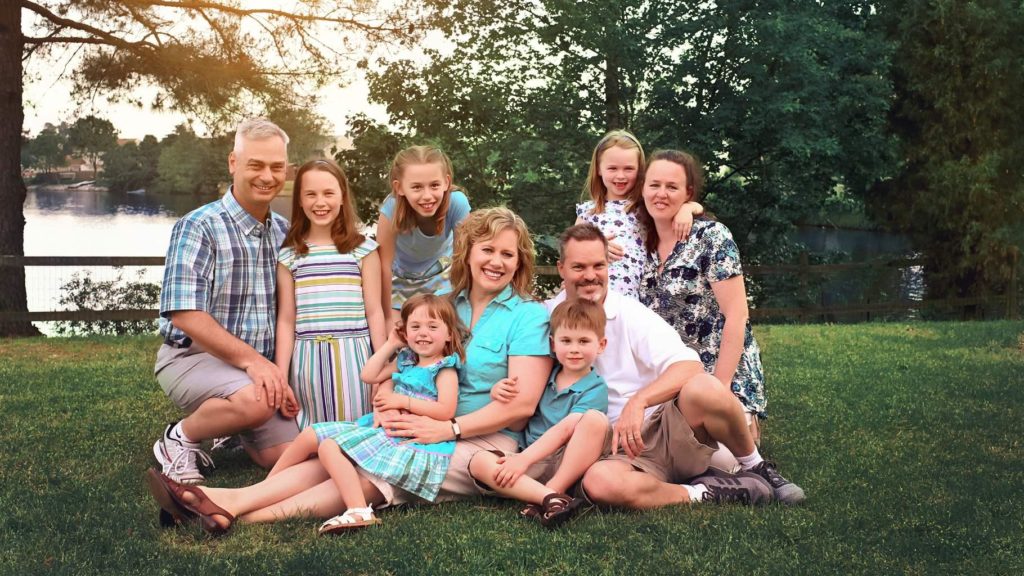
By Elaine S. Povich
Staff Writer, Stateline
Abigail and Rachelle Henderson, 15-year-old twins from Buffalo, New York, were conceived in vitro and carried to term by their mom, Rebecca.
Trevor and Aubrey Gassman, now 9 and 8 years old, who live in Oregon, were born of embryos created during the infertility treatment of Rebecca Henderson and her husband, Chris. The couple donated the embryos through a Christian agency to Dan and Kelli Gassman, and Kelli carried them to term.
Genetically, the four children are siblings. While the two families aren’t related, the parents in both families have chosen to let their kids get to know one another. They met through a Colorado agency, Nightlight Christian Adoptions, which has a program that brings together potential embryo donors and recipients.
In many ways, the children feel like family, their parents say.
“They are all such dears,” Kelli Gassman said. Her son and daughter “love their sisters. I feel like our family has been grafted into the Henderson’s family tree,” she said.
In a way they have.
Yet as embryo donation has become more common with advancements in infertility treatments, many state laws have not kept up, and there is no federal statute governing the practice. Only a few states have laws explicitly addressing embryo storage and donation.
A rush of new abortion restrictions could further complicate the matter. With the U.S. Supreme Court likely to overturn Roe v. Wade later this month, some red states have passed new bans on abortion. Both a Louisiana bill awaiting the governor’s signature and a new Oklahoma law, for example, include language that implies that embryos are “persons” under the law. Those measures could be interpreted to prohibit destruction of the embryos should couples choose not to donate them to prospective parents or to science, legal experts say. The co-sponsor of one of the bills says that was not her intent.
“The real crux for infertility treatment is what is the legal status of the in vitro fertilized egg,” said Sean Tipton, chief advocacy officer for the American Society for Reproductive Medicine, a group that advocates for reproductive choice. “There’s a lot of language in some abortion bans, that says ‘from the moment of conception’ or ‘every stage of human development.’ That kind of language puts into question the legal status of a fertilized egg.
“We are going to be in for a protracted period of uncertainty,” he said.
An ‘Underregulated’ Practice
About 400,000 embryos (fertilized eggs that have developed for six or fewer days) have been frozen since the 1970s and stored in the United States, according to a 2003 RAND Corporation study. The research firm said the vast majority of them were still controlled by the people who created them, not donated or disposed of.
Like adoption laws, the few existing laws on embryo donation mostly ensure that children are legally considered the offspring of the receiving parents. Absent specific state laws, individual legal contracts regulating the transfer of property usually apply. U.S. Food and Drug Administration rules govern testing and medical procedures.
After Leaked Roe Ruling, GOP Weighs Stricter Abortion Bans
Lori Andrews, a law professor at the Chicago-Kent College of Law and an expert in genetic technologies, calls the practice “underregulated, especially considering its impact on the next generation and families.”
Most states, she said, have laws specifying that the recipients of donated sperm are the parents of any resulting children. About half of the states extend the same rights to recipients of human egg donation, “and even fewer have embryo laws,” she said.
Last year, Colorado Democratic Gov. Jared Polis signed a law intended to help streamline and regularize embryo donation and surrogacy. The new law governs what happens if an intended parent dies before the child is born, and sets age limits and other requirements for surrogate mothers. A similar bill is under consideration in Massachusetts.
A Florida law enacted in 2016 requires that the donor of any egg, sperm or embryo relinquish all maternal or paternal rights to them and allows only “reasonable” compensation “directly related to the donation.”
Georgia’s 2009 law, one of the first to be enacted, defines embryo donation as an adoption, but stops short of extending “personhood” protections to an embryo.
“There aren’t a lot of laws around embryo donation,” said Elizabeth Nash, principal policy associate for state issues at the Guttmacher Institute, an abortion rights research group. “That can make things more difficult, in some ways, but also allows for medical practice to develop … and progress to be made in meeting the needs for patients. A legal solution isn’t always the best solution.”
Some states’ new anti-abortion measures might be interpreted to apply to frozen embryos.
Existing Louisiana law specifically states that a “fertilized human ovum is a juridical person which shall not be intentionally destroyed.” A Louisiana abortion ban approved by the legislature likewise would define personhood “from the moment of conception.” But the ban would apply to a “clinically diagnosable pregnancy,” which would not affect frozen embryos. The bill has been sent to Democratic Gov. John Bel Edwards, who is expected to sign it, according to news reports.
The Oklahoma law is a near-total ban on abortion starting at fertilization with exceptions that allow abortion for “medical emergencies.” And it includes a clause allowing citizens to bring a civil action against anyone who “aids or abets” an abortion.
Sen. Julie Daniels, the Republican co-sponsor of the law, said it is designed to apply to termination of pregnancies, not embryos. “It is my opinion that the definition of ‘abortion’ in HB4327 does not apply to [destruction of frozen embryos]. There must be ‘the purpose to terminate the pregnancy,’” she said in an email to Stateline, quoting from the law. The text defines “unborn child” as “a human fetus or embryo in any stage of gestation from fertilization until birth.”
But the law has raised concerns among patients in Oklahoma over whether it might hinder in vitro fertilization, according to The Oklahoman.
Andrews, the professor, said couples usually designate one of three choices about the disposition of extra frozen embryos: destroying them, donating them to other couples or to science, or keeping them preserved. Some of those choices, including destruction, appear not to be legal under the new laws.
“Not only is this a legally volatile area, it’s an emotionally volatile area,” she said.
If the anti-abortion laws are interpreted to protect embryos, that may result in the inability to destroy or donate them to science, leaving them frozen in perpetuity unless a recipient is found.
Shifting Away from Anonymity
Maryland attorney Margaret Swain, who represents people going through the embryo donation process, said negotiating a document between the parties takes time and thought, especially if the recipients and donors are going to be in contact.
“Traditionally, embryo and gamete donation was conducted in an anonymous model,” she said in a phone interview. “We’re seeing a real shift in that.”
Attorney Nidhi Desai, a family lawyer in Illinois, noted that today there’s “no such thing as anonymity,” because even if people want to keep their children’s origin a secret, DNA testing would make it difficult, if not impossible. She said legal documents negotiated between parties can set out the terms for contact among the children, if any.
STATELINE STORY April 26, 2021
Adoptees Press States for Access to Original Birth Certificates
Donation is becoming more frequent, according to Kimberly Tyson, vice president of Nightlight Christian Adoptions, an agency affiliated with the National Association of Evangelicals that assisted the Hendersons and the Gassmans.
She said the procedure has become much more popular since 1997, when the agency first began to work with embryos, and 950 babies have been born from donated embryos through their agency. About half of the implanted embryos result in full-term pregnancies, she said.
That agency sets up its procedure like an adoption agency in which prospective parents sign up in a registry, and donating couples get to choose the recipients.
Nightlight calls its program “Snowflake Embryo Adoption,” using terminology that tries to equate embryos with babies who are up for adoption. Clinicians and attorneys prefer the term embryo donation, and legal contracts governing the procedure mirror property transfer transactions.
The agency encourages the donors and recipients to get to know each other. Tyson said the secrecy surrounding egg, sperm and embryo donation practiced by some agencies and clinics is a “land mine” waiting to explode once the children of frozen embryos discover their genetic origins. But many clinics and agencies promise anonymity to the donors and recipients.
She points to situations in which many people who were adopted decades ago, when secrecy was paramount, have spent countless dollars and years trying to locate their birth parents. In the future, people who are the product of embryo donations could do the same.
Donating anonymously didn’t appeal to the Hendersons, said Rebecca, who after her twins were born had another girl, Johanna, without using a frozen embryo.
“I couldn’t conceive of walking down the street and seeing someone who looks like me and wondering, wondering,” she said in a phone interview. But, she said, negative thoughts crept in too. “How could I give them to someone else to raise?”
Eventually, they picked the Gassmans, and the two couples clicked. Still, there were bumps. A mother of three girls, Rebecca Henderson admitted to a little pang when she found out that the Gassmans’ first child would be a boy, since she had all girls and would have welcomed the experience of having a boy, too. “But still, that was awesome,” she said. She began collecting pictures and making a scrapbook of him for her girls.
“All the kids get along awesome,” she said. “Trevor and Johanna look like twins. We treat it as normal—this is what our family looks like.”
Stateline, an initiative of The Pew Charitable Trusts.


